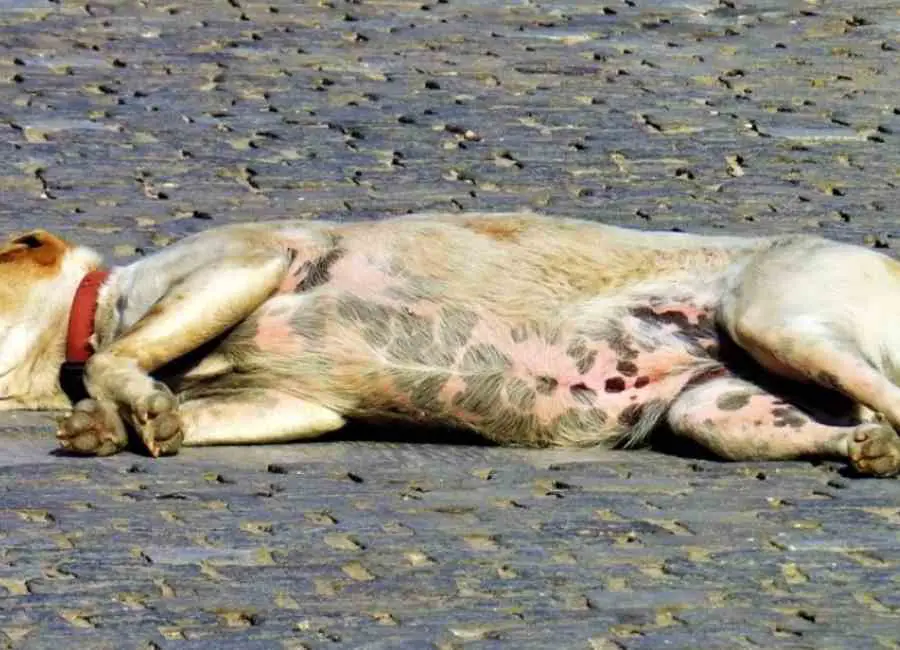14 Hints For Preventing Bloat In Dogs

Having the appropriate knowledge about preventing dog bloat can save your pet’s life.
Any dog can develop bloat, also known as gastric dilatation-volvulus (GDV), but larger breeds are more frequently affected by this potentially fatal condition.
There are a few easy precautions you can take to help protect your dog from bloat.
This blog post will discuss bloat, warning signs to look out for, and effective preventative measures.
Preventing Bloat In Dogs
Here are some common ways of preventing bloat in dogs:
Consider prophylactic gastropexy
A surgical procedure called prophylactic gastropexy joins the stomach to the abdominal wall to stop it from rotating or twisting.
Spaying or neutering can be done concurrently with this procedure.
For dogs with a high risk of developing bloats, such as Great Danes and other large breeds, prophylactic gastropexy is advised.
Feed your dog small but frequent meals
Consider giving your dog smaller, more frequent meals throughout the day rather than one or two large meals a day.
Lowering the amount of food and gas that builds up in the stomach, can help prevent bloat.
Your dog’s digestion, blood sugar levels, and overeating can all be improved by dividing their daily food intake into three or four smaller meals.
Use a slow feeder bowl
Slow feeder bowls are made to make your dog eat more slowly by requiring them to take smaller bites and chew their food longer.
By limiting the amount of air your dog swallows while eating can help prevent bloat.
Slow-feeder bowls are offered in a range of dimensions and shapes, and they can be constructed from various materials such as ceramic, metal, or plastic.
Try out various slow feeder bowl designs to determine which one suits your dog the best.
Avoid feeding your dog immediately before or after exercise
Feeding your dog right before or right after exercise increases the chance that they will bloat.
Instead, wait at least an hour before feeding your dog after exercise.
This is due to the fact that exercise can alter blood flow, increasing blood flow to the muscles while decreasing blood flow to the stomach, interfering with digestion, and raising the risk of bloating.
Limit your dog’s water intake during and after meals
Bloating risks are increased when water is consumed during or right after a meal.
To prevent bloating in dogs you should limit the amount of water your dog consumes before, during, and after meals.
However, make sure your dog has access to fresh water throughout the day and encourage them to drink water between meals or while playing.
Avoid feeding your dog a high-grain diet
High-grain diets are associated with a higher risk of bloating.
Instead, think about giving your dog a high-quality, grain-free diet.
Look for dog food that has a low carbohydrate content and high-quality protein sources like meat or fish.
To choose the ideal diet for your dog, speak with your vet.
Avoid feeding your dog from elevated bowls
Bloat risk has been associated with elevated feeding bowls. Instead, use a bowl that is on the ground to feed your dog.
This is due to the increased risk of bloat that eating from elevated feeding bowls can cause in your dog.
Avoid stress and anxiety
Bloat risk can rise with stress and anxiety. In particular, during and after meals, try to maintain your dog’s peace and tranquility.
Make sure your dog is in a relaxed and secure environment and try to keep them away from stressful situations.
Don’t allow your dog to drink too much water too quickly
Drinking too much water too quickly can increase the risk of bloat.
If your dog is thirsty after exercise or a walk, offer them water in small amounts over a period of time, rather than allowing them to drink a large amount at once.
Don’t feed your dog immediately before bedtime
Feeding your dog immediately before bedtime can increase the risk of bloat, as they are less active and may not be able to digest their food properly while sleeping.
Allow your dog to digest their food for at least two hours before bedtime.
Keep emergency supplies on hand
Keep emergency supplies on hand, such as the phone number for your veterinarian, a transportation carrier for your dog, and a first aid kit.
If you suspect that your dog is experiencing bloat, seek veterinary care immediately.
Encourage your dog to eat slowly
Some dogs are enthusiastic eaters and may swallow their food too quickly, increasing the risk of bloat.
Encourage your dog to eat slowly by using a slow feeder bowl, dividing their meals into smaller portions, or placing a large object, such as a ball or toy, in their food bowl.
Avoid feeding your dog table scraps
Avoid feeding your dog table scraps or high-fat treats, and instead provide them with healthy, dog-friendly treats.
Know your dog’s breed and risk factors
Certain dog breeds, such as Great Danes, Standard Poodles, and Boxers, are at a higher risk of bloat.
Knowing your dog’s breed and risk factors can help you take preventative measures to reduce the risk of bloat.
Speak with your veterinarian to determine if your dog is at a higher risk of bloat and what specific preventative measures may be necessary.
Causes of Bloat in dogs
Bloat in dogs is a condition caused by the accumulation of gas or fluid in the stomach and is also known as gastric dilatation and volvulus (GDV).
Some of the common causes of bloat in dogs include ingesting large amounts of food or water too quickly, being overweight or obese, age, genetics, and stress.
Certain breeds, such as Great Danes, Weimaraners, and German Shepherds, are more likely to experience bloat.
Additionally, feeding one large meal a day and moistening food before feeding can also increase the risk of bloat.
Signs of Bloat in dogs
The signs of bloat in dogs include an enlargement of the abdomen, retching, salivation, restlessness, and pain when touched. The dog may also whine or pace in distress.
Other signs of bloat can include dry heaving (retching without vomiting any food), shallow breathing, weakness, and a rapid heart rate.
If you suspect that your dog is suffering from bloat, it is important to seek veterinary care immediately.
Helping a dog suffering from bloating
It’s crucial to seek veterinary care as soon as you think your dog may be experiencing bloat symptoms.
Bloat can be fatal if not treated right away, so getting your pet medical help right away is essential.
Additionally, being aware of the symptoms and treatments for bloat may increase the likelihood that your dog will survive.
If your dog has a tendency to eat too quickly, you can use slow feeder bowls to help prevent bloat, choose smaller, more frequent meals, and keep their activity level moderate.
To help settle your dog’s stomach, you can also try some homeopathic remedies, like herbs and homeopathic remedies.
Learn more about the benefits of regular vet check-ups.
Conclusion
In conclusion, it is important to be aware of the risks of bloat in dogs and to take preventive measures to protect your beloved pup.
With the right precautions and a little extra care, you can help keep your canine friend safe and healthy.
So remember, when it comes to bloat in dogs, prevention is always the best medicine.
